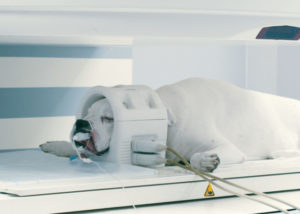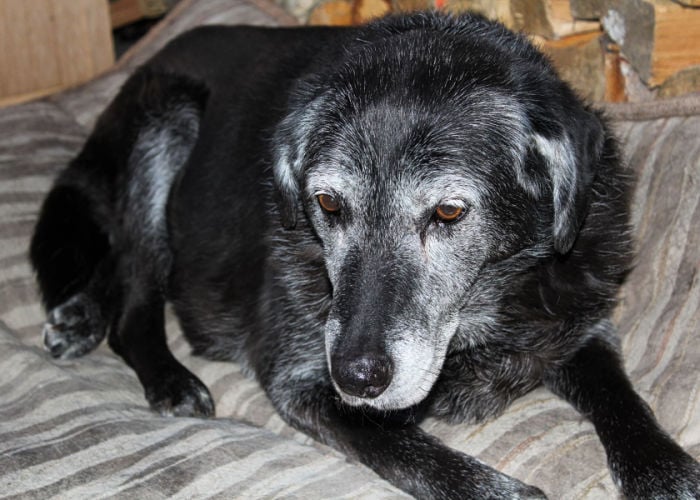Table of Contents
Dogs are a lot like humans.
We both feel emotions; we both like to belong to a family or a group.
Unfortunately, dogs also experience the same diseases as humans do (well, some of them.)
And that includes Dementia.
There are 3 dog dementia stages—and it can progress faster.
In this article, let's explore the dog dementia stages, its signs and symptoms, how it affects their quality of life, and what can we do to support our furry friends undergoing this unfortunate stage in their lives.
Dog Dementia: What is It and When Does it Start
Canine Cognitive Dysfunction in Dogs, more commonly known as Dog Dementia, is caused by changes in the brain due to old age.
This often affects a dog's memory, personality, sleep patterns, activity, and appetite.
Studies compare dog dementia to Alzheimer's disease in humans.
Apart from showing the same changes in the brain as we get older, both diseases also display the same symptoms.
According to Pets Web MD, the symptoms of dog dementia typically start by age 9.
But some recent studies also concluded that about 28% of senior dogs develop cognitive dysfunction by 11 to 12 years old.
By the time they reach 15 to 16 years old, approximately 68% of them are already suffering from dementia.
Signs of Dog Dementia
Before we get to the stages of dog dementia, it's important to be familiar first with its signs and symptoms.
Some of the common symptoms to look out for are:
- Endless pacing back and forth with no clear direction
- Disorientation and anxiousness
- Extreme irritability
- Acting dazed, staring for long periods of time
- Getting lost in familiar places
- Confusion as to how familiar things work
- Forgetting to go outside for potty breaks; accidents inside the house
- Inability to follow usual routines
- Social withdrawal; don't seek usual companionship from favorite humans
- Decreased interest in playtime
- Barking for no reason
- Changes in appetite (either not eating or eating too much)
- Changes in sleeping pattern (sleeping in the daytime instead of at night or sleeping more than what's normal)
- Sundowning (a state of confusion that usually occurs from late afternoon and lasts through the night)
- Not responsive to familiar voices
- Any other behavior that is unusual to your dog
To further understand how Canine Cognitive Dysfunction progresses and how fast it can develop, experts divided the common symptoms above into different categories:
- Spatial Orientation
- Social Interactions
- Sleep-Wake Cycles
- House Soiling
Spatial Orientation
This category is the umbrella for all symptoms related to confusion, forgetfulness, and disorientation a dog with dementia experiences.
It also includes aimless wandering and failure to recognize familiar, everyday objects.
Our dogs should know how doors work—they see us use them all the time, and they know how to use them too!
But dogs with dementia suddenly forget how it works.
They may get confused about how it opens or if it can even open on its own.
They also often get stuck in corners because they forget where they're going or they forget how to walk backward to unstuck themselves.
Social Interactions
All dogs love either playtime or cuddle time.
But dogs suffering from dementia will suddenly become disinterested in any social interactions with familiar pets and even favorite humans.
It's also possible that dogs with dementia will display extreme irritability and sudden aggression.
You may also notice their non-responsiveness to any commands or cues you know they know or to your friendly voice in general.
Sleep-Wake Cycles
Your dog may be a sleeper, but does he really sleep for an uncomfortably long time?
Owners of dogs with dementia also often notice how their dogs either sleep for long periods at any time of the day or they only sleep in the morning instead of at night.
At night, there was the pacing, the barking, and the wandering.
Sundowning is also a common symptom where the dog's confusion is more apparent when it's late in the afternoon and lasts throughout the rest of the night.
House Soiling
Just like humans with Alzheimer's, dogs with dementia also usually gets into solid and liquid accidents in the most inappropriate locations.
They may have been housebroken when they were young, but all their training goes out the window because of the changes in their brain that are causing dementia.
Apart from this, they may also lose the normal ways to signal their elimination.
You can make a checklist of the symptoms we have listed above if you suspect your dog is suffering from dementia.
This will be helpful later on in consulting your vet.
Dog Dementia Stages
Through the 4 categories of symptoms, clinical researchers were able to determine the 3 stages of dementia in dogs.
Taking note of the frequency of each symptom and when they usually appeared helped animal health practitioners understand how fast dementia progresses among dogs.
Stage 1: Mild
Dementia starts in the early stages, where symptoms are mild and easy to miss.
Dogs with dementia at this stage often start manifesting thru changes in their sleep pattern and their social interaction with their favorite humans and other familiar pets.
Owners may only mistake this for a temporary lack of energy. Maybe, my dog just wanted to rest? Maybe, he's just not in the mood?
They don't feel much alarmed at this point; that's why dogs are rarely diagnosed with dementia in the mild stage.
Stage 2: Moderate
As a dog's dementia progresses from mild to moderate, owners start to notice their dog's unusual behavior.
You'd probably be alarmed, too, if your dog had been previously house-trained, and yet accidents inside the house are getting more and more frequent.
You'll notice them getting hyperactive at night, too.
The nightly pacing may also start at this point.
As owners get alerted of these changes in their dogs' behavior, some would consult with veterinarians regarding their observations.
At this stage, the dogs will definitely require more patience and care from their owners.
Stage 3: Severe
The final stage of dog dementia is characterized as severe.
Severe because all the other existing signs tend to increase in frequency and severity.
All 4 categories of symptoms are also very much noticeable at this point.
Apart from the nightly pacing, your dog may also start barking at things that are not there.
Their lack of responsiveness is also more worrisome, and house soiling becomes more significant.
Because of this, their behavior starts to get more difficult to deal with, perhaps, even too difficult for some owners.
How Fast Does Dog Dementia Progress?
As we know, dogs age faster than humans.
Their lifespans are about one-fifth of ours.
Scientists noted that this may be the reason why dog dementia progresses faster than humans.
The same study that identified the stages of dog dementia also concluded that about a quarter of the dogs who had been diagnosed with mild dementia had progressed to moderate dementia in just 6 months–roughly 5 times faster than human Alzheimer's.
However, it's also important to note that each dog and owner may have different experiences with dog dementia.
The stages and symptoms may vary from one another.
Diagnosis of Dog Dementia
As with other diseases, it's always important to seek the advice of experts.
It's always possible that one or some of the symptoms you suspect as dementia may be caused by other diseases or illnesses your dog has.
If you have made a checklist out of the symptoms listed above, you would have to go through them with your vet.
It's better if you were able to note the frequency and circumstance of each symptom as they manifest.
A complete physical examination might be conducted, along with routine blood tests, thyroid testing, ultrasound, and X-rays, to rule out any possible underlying disease.
thyroid testing, ultrasound, and X-rays, to rule out any possible underlying disease.
If your dog has been cleared for any other medical condition, advanced imaging tests like MRI or CT Scans will eventually be conducted.
Treatment for Dog Dementia
In reality, there's not one treatment for dementia in dogs.
It's a series of processes that can only aim to slow down the disease's progress and improve the quality of life of the dog and the owner.
Environment management is the first key to doing so.
Keep doing a routine of playtime (or any active time, for that matter), socialization, and other activities that will stimulate their physical and mental being.
Keeping them busy during the daytime and exposing them to sunlight will also help regulate their sleep-wake cycle.
It's also important to pet-proof the house.
Keep their surroundings simple and as is.
Prepare diapers, pads, and waterproof beds to address the soiling incidents.
Your dog will also have to undergo behavioral therapy, and your vet may prescribe some medications to ease your dog's anxiety and help him sleep comfortably.
Also, ask your vet what food can he or she recommend for your dog.
Quality and nutritious homemade or commercial dog food is important, especially one that's rich in antioxidants.
Prevention of Dog Dementia
Another reality check: no one is exactly sure what causes dementia except that it usually comes with old age.
Because of this, it's also difficult to determine what can prevent it exactly.
But since it involves cognitive deterioration, we can only hope that keeping our dogs physically and mentally active at all ages can help keep their minds sharp and healthy.
Some of the activities you can continuously do are:
- Teaching them new tricks
- Keeping physically active together
- Feeding them a balanced and whole-food diet
- Giving them supplements for brain health
- Regular socialization
- Keeping them exposed to new experiences
- Avoid putting them in stressful situations
How to Care for a Dog with Dementia?
There's no sugar-coating it: it will be particularly challenging for you as the owner to care for your furry friend suffering from dementia.
Here are some tips on how to care for a dog with dementia:
- You're probably sensing this already, but yes. You'll need a lot of patience, patience, patience.
- Ensure your dog can always find his needs nearby at home–especially his food, water, and bed.
- Bring him outdoors for his daily exercise–30 minutes to 1 hour should be enough. Keeping him physically active all the time is important. (Consider using doggy wheelchairs if your dog can't walk anymore.)
- Of course, don't forget brain exercises! Puzzle toys, teaching them new tricks, or reinforcing old tricks should do the trick, too.
- Keep a consistent daily routine–from waking them up to feeding time to playtime. This will help reduce their confusion and anxiety and may help them sleep better at night.
- Keep the door or gate closed if your dog has the tendency to wander outside. Also, make sure he's microchipped or at least wearing a collar with his and your latest information, like name and contact number.
- As your dog's dementia progresses, it's also important for you to learn to adjust your care based on his needs.
Keep an open mind and a hopeful heart in dealing with your dog's dementia. Remember that they can only rely on you at this point to keep them safe and sound.
Dog Dementia Stages: FAQs
How long do dogs live with dementia?
Ultimately, it's difficult to predict the life expectancy of a dog with dementia.
It all depends on the overall health and welfare of the dog, after all, and how fast their cognitive abilities deteriorate.
However, there are those claiming that dogs with dementia can actually live for approximately up to 2 years.
As we know, dementia can really affect a dog's quality of life, and it can only be a matter of months or years.
Keep working with your veterinarian to monitor your dog's health and cognitive functioning.
How do you know when to put your dog down with dementia?
As owners, it's important we understand the difference between existing and living.
Sure, our dogs can exist with dementia. We're here to help them go through it, after all.
But if it affects them so that their quality of life is affected, will that be considered living still?
Eventually, you'll see and feel it when your dog is letting you know it's time.

What breed of dog is prone to dementia?
No particular breed of dog is at risk for dementia.
It can, however, be more common in smaller dog breeds, such as:
- Papillon
- Chihuahua
- Boston Terrier
- French Bulldog
- Miniature Pinscher
This is partly explained by the fact that smaller dogs typically live longer than larger dogs.
Is dog dementia worse at night?
Dogs that experience “sundowning” sleep more during the day and are awake, confused, and disturbed all night long.
Try to be regular with your dog's feeding, walking, and bedtime schedules.
A regular sleep routine may also reduce the likelihood that your woofer will experience confusion at night.
Dog Dementia Stages: Before You Go
There are only 3 dog dementia stages, and they progress fast.
This tells us, owners, to immediately take action upon the onset of early symptoms so we can help our dogs as early as we can.
Provide areas where your four-legged pet can rest peacefully.
To help him calm down at night, take him on little walks and establish a nighttime routine that includes a trip to the bathroom.
There may be no cure for Canine Cognitive Dysfunction or dog dementia, but at least we can do our best to improve their quality of life and enjoy their company for as long as we can.
















